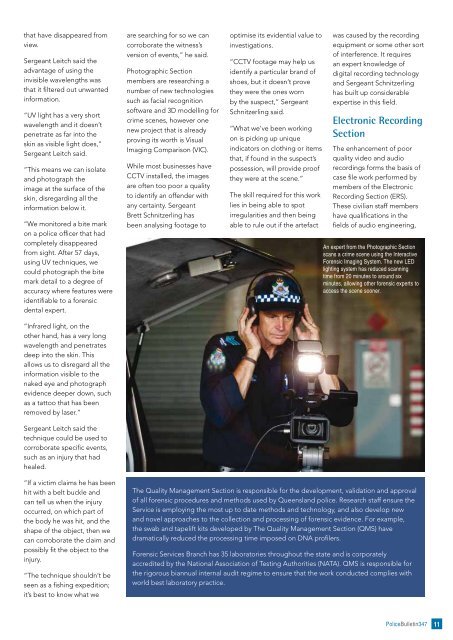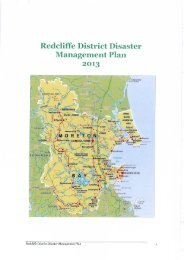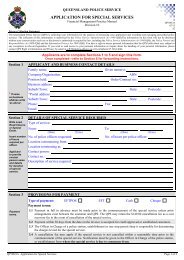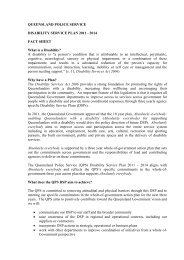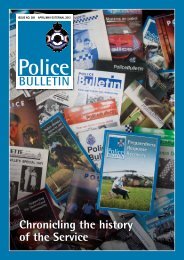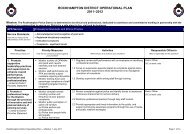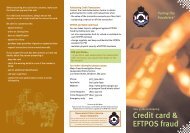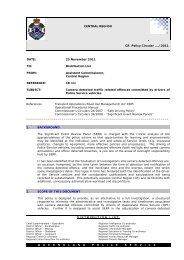FRoM CoMMissioneR ATKinson - Queensland Police Service ...
FRoM CoMMissioneR ATKinson - Queensland Police Service ...
FRoM CoMMissioneR ATKinson - Queensland Police Service ...
Create successful ePaper yourself
Turn your PDF publications into a flip-book with our unique Google optimized e-Paper software.
that have disappeared from<br />
view.<br />
Sergeant Leitch said the<br />
advantage of using the<br />
invisible wavelengths was<br />
that it filtered out unwanted<br />
information.<br />
“UV light has a very short<br />
wavelength and it doesn’t<br />
penetrate as far into the<br />
skin as visible light does,”<br />
Sergeant Leitch said.<br />
“This means we can isolate<br />
and photograph the<br />
image at the surface of the<br />
skin, disregarding all the<br />
information below it.<br />
“We monitored a bite mark<br />
on a police officer that had<br />
completely disappeared<br />
from sight. After 57 days,<br />
using UV techniques, we<br />
could photograph the bite<br />
mark detail to a degree of<br />
accuracy where features were<br />
identifiable to a forensic<br />
dental expert.<br />
“Infrared light, on the<br />
other hand, has a very long<br />
wavelength and penetrates<br />
deep into the skin. This<br />
allows us to disregard all the<br />
information visible to the<br />
naked eye and photograph<br />
evidence deeper down, such<br />
as a tattoo that has been<br />
removed by laser.”<br />
Sergeant Leitch said the<br />
technique could be used to<br />
corroborate specific events,<br />
such as an injury that had<br />
healed.<br />
are searching for so we can<br />
corroborate the witness’s<br />
version of events,” he said.<br />
Photographic Section<br />
members are researching a<br />
number of new technologies<br />
such as facial recognition<br />
software and 3D modelling for<br />
crime scenes, however one<br />
new project that is already<br />
proving its worth is Visual<br />
Imaging Comparison (VIC).<br />
While most businesses have<br />
CCTV installed, the images<br />
are often too poor a quality<br />
to identify an offender with<br />
any certainty. Sergeant<br />
Brett Schnitzerling has<br />
been analysing footage to<br />
optimise its evidential value to<br />
investigations.<br />
“CCTV footage may help us<br />
identify a particular brand of<br />
shoes, but it doesn’t prove<br />
they were the ones worn<br />
by the suspect,” Sergeant<br />
Schnitzerling said.<br />
“What we’ve been working<br />
on is picking up unique<br />
indicators on clothing or items<br />
that, if found in the suspect’s<br />
possession, will provide proof<br />
they were at the scene.”<br />
The skill required for this work<br />
lies in being able to spot<br />
irregularities and then being<br />
able to rule out if the artefact<br />
was caused by the recording<br />
equipment or some other sort<br />
of interference. It requires<br />
an expert knowledge of<br />
digital recording technology<br />
and Sergeant Schnitzerling<br />
has built up considerable<br />
expertise in this field.<br />
Electronic Recording<br />
Section<br />
The enhancement of poor<br />
quality video and audio<br />
recordings forms the basis of<br />
case file work performed by<br />
members of the Electronic<br />
Recording Section (ERS).<br />
These civilian staff members<br />
have qualifications in the<br />
fields of audio engineering,<br />
An expert from the Photographic Section<br />
scans a crime scene using the Interactive<br />
Forensic Imaging System. The new LED<br />
lighting system has reduced scanning<br />
time from 20 minutes to around six<br />
minutes, allowing other forensic experts to<br />
access the scene sooner.<br />
“If a victim claims he has been<br />
hit with a belt buckle and<br />
can tell us when the injury<br />
occurred, on which part of<br />
the body he was hit, and the<br />
shape of the object, then we<br />
can corroborate the claim and<br />
possibly fit the object to the<br />
injury.<br />
“The technique shouldn’t be<br />
seen as a fishing expedition;<br />
it’s best to know what we<br />
The Quality Management Section is responsible for the development, validation and approval<br />
of all forensic procedures and methods used by <strong>Queensland</strong> police. Research staff ensure the<br />
<strong>Service</strong> is employing the most up to date methods and technology, and also develop new<br />
and novel approaches to the collection and processing of forensic evidence. For example,<br />
the swab and tapelift kits developed by The Quality Management Section (QMS) have<br />
dramatically reduced the processing time imposed on DNA profilers.<br />
Forensic <strong>Service</strong>s Branch has 35 laboratories throughout the state and is corporately<br />
accredited by the National Association of Testing Authorities (NATA). QMS is responsible for<br />
the rigorous biannual internal audit regime to ensure that the work conducted complies with<br />
world best laboratory practice.<br />
<strong>Police</strong>Bulletin347 11


